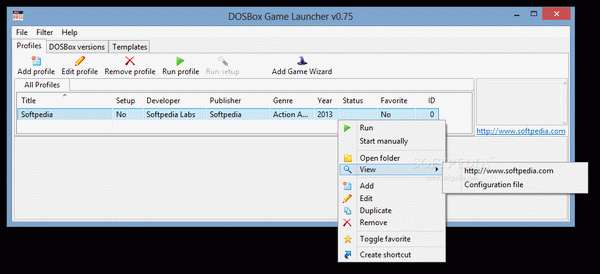DBGL 0.91 Crack With Activator Latest 2025
DBGL is an open-source front end for DOSBox that helps you launch and configure your DOS games. It offers support for D-Fend profile importing options and lets you set up and work with several DOSBox versions, such v0.74, v0.73, v0.72, v0.71, v0.70, v0.65, v0.63 or custom/SVN builds.
This is a Java-based application so you need to firstly deploy the working environment on your computer and then run the utility.

Download DBGL Crack
| Software developer |
Ronald Blankendaal
|
| Grade |
4.5
1426
4.5
|
| Downloads count | 13969 |
| File size | < 1 MB |
| Systems | Windows All |
The program can be run on your system without having to go through a normal installation process. You only need to run the EXE file in order to gain access to the tool’s GUI.
The best part about the portable mode is that the app doesn’t store leftover files and write entries in your Windows registry, so you may run it without administrative privileges. Plus, you may copy it on any USB flash drive or other devices and carry it with you.
DBGL sports a clean and multi-tabbed layout that offers you quick access to several key features of the program, namely Profiles, DOSBox versions and Templates.
It also integrates a wizard that gives rookies the possibility to easily add and configure a new game. The step-by-step approach enables them to enter the game’s title, specify whether it needs to be installed or it has already been installed from the original source media, as well as provide the main executable (EXE, COM, BAT, ISO, CUE, IMA, ZIP, 7Z). Furthermore, you can choose between several templates and select the machine, core and cycles.
DBGL allows you to import profile data from GamePack archives, DOSBox configuration files, executable files or disk images. Additionally, you may import information for a single profile from CONF, EXE, COM, BAT, IMG, CP2, DCF and JRC files.
D-Fend profiles can be added from DAT files and cleaned up by removing various sections (e.g. IPX, SDL, modem). When it comes to exporting options, you may opt for saving profiles (DOSBox configuration and profile info) or games (game data, DOSBox configuration and profile info) and details about the title, author and notes. Plus, you may save the list with all your profiles to CSV, TXT or HTML file format.
Several profile management features enable you to edit, remove or duplicate profiles, mark the selected profiles as your favorite ones, create a desktop shortcut for the target profile, as well as start it manually or run it directly from the main panel. You can also migrate profiles from one location to another.
DBGL Serial helps you add a new profile to the list by entering general details (e.g. title, developer, genre, publisher) and custom information, configuring several settings (e.g. set priorities, pick the language file, choose between several templates), and tweaking the display (e.g. window resolution, full screen, frame skip), machine (e.g. CPU core, type and cycles, memory size), audio (e.g. silent mode, sample rate, block size, MIDI device), I/O options, custom commands, and mounting parameters.
The app allows you to build up a list with DOSBox versions and add a new one by entering information about the title, path, configuration file, parameters and version. In addition, you may edit, remove or run the selected version.
It also comes packed with a list of templates that can be edited, removed and run, and you can manually add a new one. The tool lets you add a filter to the profile list by displaying only profiles with the title, setup, developer, publisher, genre or another criterion, and clean up the database by removing the unused autocomplete entries.
All in all, DBGL comes with a smart set of features for helping you work with a DOSBox game launcher. Thanks to its intuitive layout and powerful options for configuring and running DOS games, it is suitable for rookies and professionals alike.
